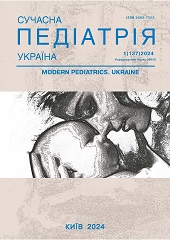Clinical results of enhanced recovery after surgery in children after pectus excavatum repair
DOI:
https://doi.org/10.15574/SP.2024.137.94Keywords:
children, enhanced recovery, chest deformity, Nuss procedure, pediatricsAbstract
The funnel-shaped deformity of the chest is the most common defect of the chest, which can cause cosmetic problems, but also a decrease in tolerance to physical activity, cause fatigue, shortness of breath and chest pain.
The application of the enhanced recovery protocol and rehabilitation interventions after Nuss procedure are poorly described in the literature.
Purpose - to evaluate the clinical results of using a modified protocol of enhanced recovery after surgical correction of pectus excavatum in children.
Materials and methods. The results of the treatment of 79 patients with a funnel-shaped chest deformity aged (14.2±1.6) who underwent surgical correction of the deformity according to Nuss method were analyzed. Two groups of patients were analyzed, according to the protocol of postoperative management: the Group I (n=20) - patients of traditional postoperative management, the Group II (n=59) - according to the the enhanced protocol of recovery. In the Group II, psychological and physical training was additionally included in the preoperative plan.
Results. The groups were the same in terms of age, Haller index, and time of surgery (p>0.05). The length of stay in the hospital was significantly (p<0.001) shorter in patients of the Group II. The use of the epidural analgesia method in patients of the Group II made it possible to significantly reduce both the dose and the duration of taking opioid analgesics to 1 day, in contrast to the Group I (up to 3 days). The lack of pleural drainage enabled the patient to become more active after a day - to get up, walk, and take some procedures.
Conclusions. The protocol of the enhanced postoperative recovery, which includes a program of rehabilitation treatment, early removal of the urinary catheter and early verticalization of the patient, improves the quality of recovery of patients after reconstruction of funnel-shaped deformity of the chest and reduces the length of stay of patients in hospital treatment after surgery.
The research was carried out in accordance with the principles of the Declaration of Helsinki. The research protocol was approved by the Local Ethics Committee of the participating institution. Informed consent of the patients was obtained for the research.
No conflict of interests was declared by the authors.
References
Acosta J, Bradley A, Raja V, Aliverti A, Badiyani S, Motta A et al. (2014). Exercise improvement after pectus excavatum repair is not related to chest wall function. Eur J Cardiothorac Surg. 45(3): 544-548. https://doi.org/10.1093/ejcts/ezt473; PMid:24067751
Aronson DC, Bosgraaf RP, Merz EM, van Steenwijk RP, van Aalderen WM, van Baren R. (2007). Lung function after the minimal invasive pectus excavatum repair (Nuss procedure). World J Surg. 31(7): 1518-1522. https://doi.org/10.1007/s00268-007-9081-8; PMid:17534548 PMCid:PMC1913173
Nuss D, Kelly RE Jr, Croitoru DP, Katz ME. (1998). A 10-year review of a minimally invasive technique for the correction of pectus excavatum. J Pediatr Surg. 33(4): 545-552. https://doi.org/10.1016/S0022-3468(98)90314-1; PMid:9574749
Pilegaard HK, Licht PB. (2008). Early results following the Nuss operation for pectus excavatum - a single-institution experience of 383 patients. Interact Cardiovasc Thorac Surg. 7(1): 54-57. https://doi.org/10.1510/icvts.2007.160937; PMid:17951271
Redding GJ, Kuo W, Swanson JO, Phillips GS, Emerson J, Yung D et al. (2013, Aug). Upper thoracic shape in children with pectus excavatum: impact on lung function. Pediatr Pulmonol. 48(8): 817-823. https://doi.org/10.1002/ppul.22660; PMid:22912067
Reismann M, von Kampen M, Laupichler B, Suempelmann R, Schmidt AI, Ure BM. (2007). Fast-track surgery in infants and children. J Pediatr Surg. 42(1): 234-238. https://doi.org/10.1016/j.jpedsurg.2006.09.022; PMid:17208572
Uemura S, Nakagawa Y, Yoshida A, Choda Y. (2003, May). Experience in 100 cases with the Nuss procedure using a technique for stabilization of the pectus bar. Pediatr Surg Int. 19(3): 186-189. https://doi.org/10.1007/s00383-002-0915-z; PMid:12768312
West MA, Horwood JF, Staves S, Jones C, Goulden MR, Minford J et al. (2013, Sep). Potential benefits of fast-track concepts in paediatric colorectal surgery. J Pediatr Surg. 48(9): 1924-1930. https://doi.org/10.1016/j.jpedsurg.2013.02.063; PMid:24074669
Wharton K, Chun Y, Hunsberger J, Jelin E, Garcia A, Stewart D. (2020). Successful use of an enhanced recovery after surgery (ERAS) pathway to improve outcomes following the Nuss procedure for pectus excavatum. J Pediatr Surg. 55(6): 1065-1071. https://doi.org/10.1016/j.jpedsurg.2020.02.049; PMid:32197827
Yu P, Wang G, Zhang C, Liu H, Wang Y, Yu Z, Liu H. (2020, Jun). Clinical application of enhanced recovery after surgery (ERAS) in pectus excavatum patients following Nuss procedure. J Thorac Dis. 12(6): 3035-3042. https://doi.org/10.21037/jtd-20-1516; PMid:32642226 PMCid:PMC7330763
Downloads
Published
Issue
Section
License
Copyright (c) 2024 Modern pediatrics. Ukraine

This work is licensed under a Creative Commons Attribution-NonCommercial 4.0 International License.
The policy of the Journal “MODERN PEDIATRICS. UKRAINE” is compatible with the vast majority of funders' of open access and self-archiving policies. The journal provides immediate open access route being convinced that everyone – not only scientists - can benefit from research results, and publishes articles exclusively under open access distribution, with a Creative Commons Attribution-Noncommercial 4.0 international license (СС BY-NC).
Authors transfer the copyright to the Journal “MODERN PEDIATRICS. UKRAINE” when the manuscript is accepted for publication. Authors declare that this manuscript has not been published nor is under simultaneous consideration for publication elsewhere. After publication, the articles become freely available on-line to the public.
Readers have the right to use, distribute, and reproduce articles in any medium, provided the articles and the journal are properly cited.
The use of published materials for commercial purposes is strongly prohibited.

